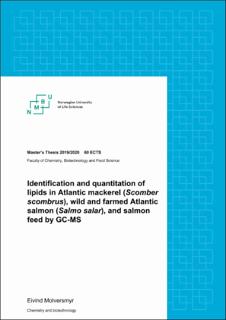| dc.description.abstract | The main objective of this study was to elucidate and quantitate the fatty acid (FA) profiles of mackerel (Scomber scombrus), wild and farmed salmon (Salmo salar), and salmon feed. Due to the increasing proportions of vegetable oils in salmon feed, it was of interest to evaluate its effects on the FA profile of farmed salmon. To determine how much the feed affects the FAs in farmed salmon, it was of interest to compare the concentrations of the important n-3 FAs eicosapentaenoic acid (EPA) and docosahexaenoic acid (DHA) in wild salmon and farmed salmon. It was also of interest to look at the FA profile of another fatty wild fish, mackerel, to compare it to the salmon. The fish were evaluated from a health perspective by discussing the contents of n-3 and n-6 FAs, saturated fatty acids (SFAs), monounsaturated fatty acids (MUFAs), and polyunsaturated fatty acids (PUFAs). The nutritional quality indices; atherogenicity index, thrombogenicity index, as well as the n-6/n-3 ratio were also subsequently discussed.
Total FA profile in fish and feed was found using a gas chromatograph coupled with a single- quadrupole mass spectrometer. The method of extraction and derivatisation of the lipids had already been established and included extraction of the lipids with solvents, and further derivatisation to fatty acid methyl esters. The fish lipids were subsequently fractioned by off- line solid-phase extraction to neutral lipids, free fatty acids, and polar lipids. The lipid content was found to be 3.1 ± 1.5%, 2.14 ± 0.32%, and 8.97 ± 0.63% of muscle in respectively mackerel, wild salmon, and farmed salmon. A total of 37, 36, 35, and 34 FAs were found in respectively mackerel, wild salmon, farmed salmon, and salmon feed adding up to 39 unique FAs. The content of n-3- and n-6 FAs were greatest in farmed salmon as a result of the feed composition. The contents of SFAs, MUFAs, and PUFAs in mackerel were respectively 33.1, 35.3, and 31.6%, while 15.0, 55.4, and 29.6%, respectively in farmed salmon, and 26.3, 47.4, and 26.3%, respectively in wild salmon. Both wild salmon and farmed salmon contained approximately the same amount of EPA and DHA with 520 and 523 mg/100 g fish muscle, respectively. The mackerel, however, was significantly richer in EPA and DHA (1,004 mg/100g fish muscle) compared to the salmons. The results suggested that substituting a diet of farmed salmon with either wild salmon or mackerel might prove more nutritionally favourable. | en_US |
| dc.description.abstract | Hovedmålet med denne studien var å identifisere og kvantifisere fettsyreprofiler av makrell (Scomber scombrus), vill- og oppdrettslaks (Salmo salar) og laksefôr. På grunn av de økende andelene av vegetabilske oljer i laksefôr, var det av interesse å evaluere effekten på oppdrettslaksens fettsyreprofil. For å bestemme hvor mye fôret påvirker fettsyrene hos oppdrettslaks, var det av interesse å sammenligne konsentrasjonene av den viktige n-3 fettsyrene eikosapentaensyre (EPA) og dokosaheksaensyre (DHA) hos villaks og oppdrettslaks. Det var også interessant å se på fettsyreprofilen til en annen fet villfisk, makrell, for å sammenligne den med laksen. Fiskene ble evaluert fra et helsemessig perspektiv ved å diskutere innholdet i n-3 og n-6 fettsyrer, mettede fettsyrer (SFA), enumettede fettsyrer (MUFA) og flerumettede fettsyrer (PUFA). Næringsmessige kvalitetsindekser; atherogenisitetsindeks, trombogenisitetsindeks og n-6/n-3-forholdet ble også deretter diskutert. | en_US |

